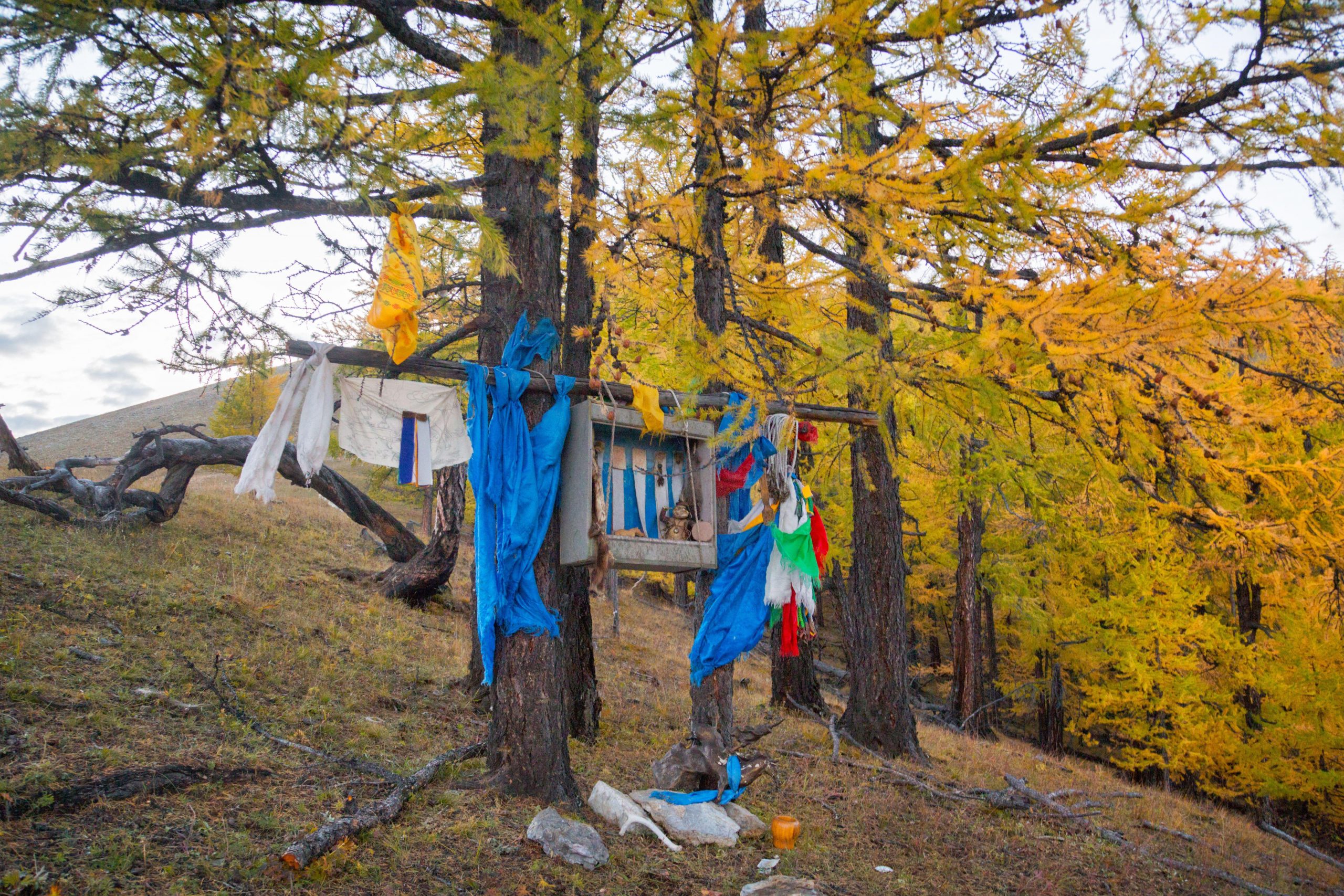Animistic and Shamanic Elements of Asian Buddhism
Should convert Buddhists in the West reclaim these ancestral elements? The post Animistic and Shamanic Elements of Asian Buddhism appeared first on Tricycle: The Buddhist Review.

As a climate scientist, I feel a deep dread around the climate crisis. However, the kind of change I advocate for extends far beyond simply reducing our carbon emissions footprint of greenhouse gases to address the climate crisis in isolation. The Earth is initiating us into a new way forward. For the past two years, I have been passionately advancing a framework for transformation and movement-building that I call Reindigenzing. I have been arguing that without place-based Indigenous spiritualities, we cannot protect the world’s amazing biodiversity, engage in trauma healing, or develop ecological resilience. To this end, I believe that Western Buddhism itself needs to be “Reindigenized.”
There are profound similarities between the spiritual worldviews and practices of Tribal (or Indigenous) Nations and Buddhist lineages in Asia that are often not talked about or taught by mainstream Western Buddhist leaders in the US. I feel that this omission of kincentric, tantric, shamanic, and animist components of Buddhism is not serving Western Buddhist practitioners, communities, or centers in these times of the global polycrisis.
Polycrisis, originally a Eurocentric construct, is a cluster of interdependent global risks, such that their overall impact exceeds the sum of its individual parts, and that significantly threaten humanity’s survival. Often, European policy experts include in their definition of polycrisis: 1) frequent extreme events fueled by the climate crisis, water shortages, human health burden, and biodiversity loss due to pollution; 2) declining institutional legitimacy due to the rise of fascist authoritarianism; 3) increasing economic, food, energy, and water insecurities; 4) rising ideological or religious extremism; 5) refugee crises; and 6) genocidal violence arising from geopolitical conflict. For me, the meaning of the global polycrisis must also include: 7) escalating socioeconomic inequities across race, religion, caste, class, and countries; 8) separation of empowered Indigenous ecological wisdom keepers from their lands; and 9) acute and ever- deepening mental health crises due to unattended layers of trauma.
The Earth is initiating us into a new way forward.
In Asia, Buddhism adopted, enlarged, refined, or was even defined by the more ancient Earth-based Indigenous spiritualities that predated Buddhism or even Hinduism, which includes shamanism. In this piece, I define shamanism as a practice where individuals, i.e., shamans, act as intermediaries between the spiritual and physical worlds, communicating with ancestors, spirits, deities, and invisible (animistic) realms of animals, plants, rivers, and mountains for healing and guidance. Furthermore, in her foreword to the book The Shamanic Bones of Zen, Paula Arai describes shamanism as “imparting wisdom that transcends birth and death.” In recent decades, many Buddhist teachers and researchers have pointed out that Buddhism was stripped of some of its crucial shamanic, animistic, or tantric elements when it was brought from Asia to America in favor of a “modernized” tradition that focused more solely on seated meditation and mindfulness practices. Even some of the more ritual-based Buddhist lineages in the US have left out some of the Indigenous aspects of Asian Buddhism. While the Buddha taught that all invisible realms are impermanent (a part of samsara and subject to dependent origination), nevertheless, both Theravada and Mahayana Buddhist scriptures repeatedly acknowledge the existence and intelligence of these invisible realms and even suggest ways to build relationships with them.
As it spread across Asia, Buddhism was deeply influenced by animism, a belief system that sees all elements of the natural world—animals, plants, rivers, mountains, and even objects—as alive, sentient, intelligent, and imbued with a consciousness. These influences reflect Asian Buddhism’s engagement with Indigenous spiritual practices, incorporating elements from Taoism, Shintoism, shamanism, and the Tibetan Bon religion. These shamanic aspects are prominent in many forms of Buddhism, such as Tibetan/Vajrayana Buddhism, Zen Buddhism in Japan, as well as the Shingon and Tendai (Mikkyo) esoteric branches of Japanese Buddhism, Korea’s Jingak Order, Theravada forest traditions, and Southeast Asian folk Buddhism. These Indigenous dimensions express themselves within various Buddhist spiritual practices and techniques, including the following:
1. Entering into Altered States of Consciousness
Shamanism often involves entering altered states of consciousness for spiritual work. Similarly, advanced Buddhist meditation practices aim to transcend ordinary (small-self) perception and move toward shunyata, or the formless jhanas. Techniques for developing samadhi (concentration) and vipassana (insight) can lead to states where practitioners feel deeply connected to universal invisible energies. Tibetan Buddhist practices like deity yoga involve visualization and identification with a deity, akin to shamanic spirit possession or invocation. Seated silent meditation is not the only way to enter these states of mind—many Buddhist traditions focus on long hours of chanting or prostrations instead of seated meditation. My first sweat lodge (a common Native American practice) felt like a compressed purification ritual similar to an intense seven-day Zen retreat (sesshin).
2. The Role of the Teacher, Ordained Monk, or Lama as a Mediator
In some Buddhist traditions, monks, roshis, lamas, or spiritual leaders serve as intermediaries between humans and spiritual forces, a role analogous to Indigenous elders or shamans. They may conduct rituals for healing, protection, or exorcism, often invoking specific deities or using symbolic tools to channel spiritual power. These rituals often involved symbolic and/or “spiritually alive” objects. Buddhism incorporates similar tools, including:
Prayer wheels, bells, Zen staffs, whisks, and drums, used in rituals to invoke spiritual forces Mandalas, intricate designs symbolizing the universe, used as spiritual maps, guiding meditation or connecting with cosmic energies The phurba in Tibetan Buddhism, which functions as a tool for balancing energies/spirits Close-up of shamanic percussion instruments: drums, mallets, and meditation bells. | Image via Fabián Ponce / Alamy Stock Photo
Close-up of shamanic percussion instruments: drums, mallets, and meditation bells. | Image via Fabián Ponce / Alamy Stock PhotoLikewise, a key Indigenous elder or shaman’s role is to guide souls after death, a practice mirrored in Buddhist traditions like:
Bardo Thodol (The Tibetan Book of the Dead), which provides instructions for navigating the intermediate states (bardo) between death and rebirth Chanting rituals associated with Theravada monks or Zen priests performed to assist the dead in achieving complete and full passing from the world of the living or a favorable rebirth3. Connection with and Appeasement of Spirit Worlds
Many Asian Buddhists believe in spirits and nonhuman invisible energy fields. Across different Buddhist traditions, there is an acknowledgment of beings such as gods (devas), demigods (asuras), serpents (nagas), and hungry ghosts (pretas), which echo shamanic cosmologies of multiple invisible spiritual realms. Practices to pacify malevolent spirits or seek blessings from local deities were, and are still, quite common in Asia, including but not limited to the presentation of offerings at Shinto shrines and spirit houses.
4. Healing Rituals
Like Indigenous Peoples, Buddhists engage in rituals and chants believed to have healing properties. The Buddha is often referred to as the “Great Physician,” who provides teachings to heal the suffering of samsara. Vajrayana Buddhism incorporates rituals specifically for physical and spiritual healing, and, similarly, certain lineages of Asian Buddhism have honored the more “feminine” aspects of relating to body, mind, and community. For example:
Like Indigenous traditions across the world, certain lineages of Buddhists in Asia considered menstrual blood—as well as the womb and placenta—as sacred and very powerful. In her study of the perception of menstruation among Tibetan women, Kara Spafford notes how menstrual blood is associated with “producing magical powers during ancient tantric rituals.” In a piece for the Guardian, Dr Camilla Power, a British anthropologist, has noted the Indigenous belief that, “menstruating women and girls have privileged shamanic access to the spirit world.” The recitation of mantras, like the Om Mani Padme Hum in Tibetan Buddhism or Namu myohorengekyo in Nichiren Buddhism, is believed to purify negative energies and promote well-being. Forest monks in Southeast Asia often use herbal remedies and blessings, blending Buddhist teachings with local shamanic healing traditions.5. Nature Worship
As Buddhism spread across Asia, it integrated with local animistic and shamanic traditions, which included nature worship. In Southeast Asia, Buddhist monks perform protective rituals invoking local spirits and deities associated with specific places and natural elements. In Japan, Zen Buddhists absorbed elements of Shinto animism and emphasized a spiritual connection with nature and spirits (kami). Sacred trees, such as the Bodhi tree under which the Buddha attained enlightenment, hold deep spiritual significance. Many Buddhist practices and pilgrimages are centered on natural sites, as they are seen as imbued with spiritual energy.
6. Dreams, Divination, and Prophecy
Indigenous shamanic practices often involve divination, and in some Buddhist traditions, monks and lamas perform similar roles. Mo divination in Tibetan Buddhism uses dice or other tools to predict outcomes and offer guidance. Oracles in Tibetan Buddhism, such as the Nechung Oracle, are consulted for spiritual insight and prophecy. While American Buddhist teachers might not interpret dreams, it is not uncommon for American Zen teachers to consider dreams to be a pathway for clearing out energies during retreats (sesshins).
7. Protection and Exorcism
Shamanism often deals with protection against malevolent forces and appeasing elements and sacred sites, and Buddhism incorporates similar practices. The chanting of protective sutras (e.g., the Heart Sutra or Lotus Sutra) or mantras is believed to ward off negative energies. Buddhist rituals involve prayers, as well as fire or water offerings. This is not unlike the dances for fire and water used by some Indigenous communities to communicate with the elements.
Buddhist traditions and the spiritual traditions of Tribal Nations (or Indigenous Peoples) share several foundational perspectives, even though their cultural expressions might differ, especially in the West. These commonalities reflect shared insights into humanity’s relationship with nature, the cosmos, and the sacred.
1. Reverence for Interconnection and Interbeing
Central to Buddhist teachings is interdependence (pratityasamutpada), which highlights the interconnectedness of all phenomena. Everything arises in dependence on everything else, embodying mutual co-arising. Like Indigenous elders, Buddhists in Asia often communicated with “spirit” (i.e., the energy that moves in everything), including in departed ancestors, elements, lands, ecosystems, waters, plants, animals, and rocks. Indigenous Peoples’ worldviews also emphasize the unified web of life, where humans, animals, plants, elements, and spirits are intricately connected. Actions are understood to ripple through this network, affecting the whole.
2. Cyclical and Sacred Views of Time
In Buddhist teachings, time is seen as cyclical, with the concepts of samsara (the cycle of birth, death, and rebirth) and impermanence (anicca) emphasizing the constant flux and renewal of existence. Similarly, many Indigenous cultures also perceive time as cyclical, marked by the rhythms of nature, seasons, and life cycles. Ceremonies and rituals are often tied to these natural rhythms.
3. Deep Relationship with Nature
Nature is integral to Buddhist practice, as it often served as a teacher and refuge across different traditions. Monastics traditionally lived in forests, meditating and harmonizing with the natural world. Likewise, indigenous spirituality is deeply rooted in the land. Forests, rivers, mountains, and other natural elements are not just resources but are regarded as sacred relatives—alive and deserving of respect.
4. Direct Experiential Pathways to Wisdom and Communion
The Buddhist path to enlightenment involves direct experience through meditation, mindfulness, and insight into the nature of reality. Practices often guide individuals toward union with universal truths. Indigenous spiritualities also emphasize experiential and direct knowledge, often gained through rituals, vision quests, or shamanic journeys that reveal the interconnectedness of life and the wisdom of the spirit world. Both Buddhist and Indigenous Nations’ traditions across the world ask their practitioners to be mindful of the five senses. Communication with the unseen spirit world happens through calming the thinking mind and then being nonconceptually aware of sounds, images, body sensations, smells, thoughts, and emotions and what appears in the world beyond our body in the environment.
5. Nonduality, “Not Separate,” and the Sacredness of All Life
Nonduality (Advaya or Advaita) is a key Buddhist concept with roots in earlier Vedic traditions, teaching that distinctions between self and other, sacred and mundane, are illusory. This fosters reverence for all forms of life as manifestations of the same ultimate reality. In some lineages, this idea extends even further, positing that there is no separation between conventional delusions and ultimate truth, or between samsara and nirvana. Indigenous perspectives often dissolve barriers between the spiritual, emotional, and material worlds, viewing all of existence as inherently sacred and interconnected.
6. Communal Compassionate Practices
Sanghas (communities) play a vital role in Buddhist practice, emphasizing collective support and shared spiritual work. Indigenous rituals and ceremonies are often communal, reinforcing bonds among human participants and their shared connection to the land and spirit world.
7. Ethical Stewardship Amidst Climate Crisis
Teachings on right action (sila) emphasize compassion and nonharming (ahimsa) toward all beings. Ecodharma movements build on this, advocating for environmental stewardship rooted in Buddhist ethics. Indigenous spirituality also teaches responsibility toward the Earth, emphasizing sustainability, gratitude, and reciprocity with all beings. Both Buddhism and Indigenous traditions offer frameworks for responding to the climate crisis by encouraging a spiritual and ethical reorientation toward harmony with nature, respect for all beings, and the recognition of the interdependent nature of reality. By humbly drawing on these shared values, modern societies can cultivate a deeper sense of responsibility for the Earth.
Can Western Buddhists fully appreciate the practices and ceremonies of Tribal Nations that pay homage to natural elements (mountains, rivers, and land) as well as sacred aspects of our own emotions (e.g., grief, rage, and fear)? As Eduardo Duran (Apache/Tewa), author of Buddha in Redface, says, “I sense that the Western psyche, with its grounding in the Cartesian (linear Newtonian) worldview, somehow stays separated from nature. People go inside themselves and dissolve themselves, but they don’t connect with natural processes.” If American Buddhists don’t Reindigenize and connect with “spirits” of the natural world and commune with our local ecosystems at a deep spiritual level, our ability to protect our ecosystems and communities might be diminished in these perilous times.
For me, Reindigenizing has four essential pillars:
1. Developing connection with hurting parts of our own bodies and minds
2. Developing connection with ‘othered’ parts of our human community
3. Developing connection with our local ecosystems
4. Developing connection with invisible realms
A vital pillar of the Reindigenizing of organizations is that they must be rooted in a place: land, ecosystem, or watershed. Tsultrim Allione, founder of Tara Mandala in Colorado, has noted something crucial: Padmasambhava, a revered figure in Tibetan Buddhism, widely considered to be a Buddha and the founder of the Nyingma school, connected with the local spirits of Tibet before Buddhism was able to take root in Tibet. In the same way, can American Buddhists connect with local spirits in harmony with the Tribal Nations of the Turtle Island (North and South America)?
Without place-based Indigenous spiritualities, we cannot protect the world’s amazing biodiversity, engage in trauma healing, or develop ecological resilience.
To this end, modern practitioners in the US should also study Asian Buddhist teachings with deep respect and avoid cultural appropriation. Patient trust-building, apprenticeship, and collaboration with Indigenous and other BIPOC spiritual leaders is necessary to Reindigenize Buddhism. But when we have guidance, permission, and appropriate training, incorporating Earth-based rituals and ceremonies into Buddhist retreats and workshops could also have some immediate benefits beyond the larger impact on our planetary climate and biodiversity.
1. Increasing Cultural Relevancy and Accessibility
Mainstream Western convert Buddhist spaces often reflect Eurocentric or academic interpretations of Buddhism, which can exclude nonwhite and queer cultural expressions. Many Indigenous and African-descended cultures emphasize Earth-based spirituality, rituals, and ceremonies that honor interconnectedness with nature. Reintegrating shamanic practices in Buddhist retreats could resonate deeply with participants from these backgrounds, fostering a sense of belonging. These elements might offer more inclusive entry points into Buddhist practice for individuals who feel alienated by strictly meditative or intellectual frameworks often associated with Westernized Buddhism. Reindigenized Buddhism may appeal more to younger, queer, and BIPOC individuals, particularly those whose ancestral, cultural, or spiritual traditions align with Indigenous or shamanic practices.
2. Offering More Healing, Embodiment, and Community Building
BIPOC practitioners frequently discuss how Western Buddhism’s focus on no-self (anatta) and oneness can dismiss their lived realities of racialized oppression. Earth-based rituals and shamanic ancestral practices, often grounded in community and embodied healing, can provide alternative paths to liberation that honor those lived realities. These rituals, in combination with community-level skillful grief and rage work, can emphasize collective participation and mutual support such that people from diverse backgrounds feel connected not only to the teachings but to one another.
3. Anchoring Practice in a Commitment to Environmental and Social Justice
Many BIPOC communities have cultural traditions tied to environmental stewardship and justice. By genuinely respecting rights of Tribal Nations and reincorporating Earth-centered shamanic and animistic practices, Buddhist centers could align more closely with these values, demonstrating a commitment to intersectional justice that attracts socially engaged practitioners.
Thus, Reindigenizing of Western convert Buddhist lineages by the reintegration of Earth-based animistic worldviews, rituals, and shamanic elements could help diversify Buddhist retreat participation. And doing this, while building genuine relationships with Tribal Nations in the US (Turtle Island), will create a fertile ground for supporting biodiversity or place-based climate actions and enable Buddhist sanghas to be a transformative and illuminating force and a beacon in these grave and uncertain times.
◆
This article was adapted from a piece originally published on Kritee Kanko’s website.

 Fransebas
Fransebas 






























